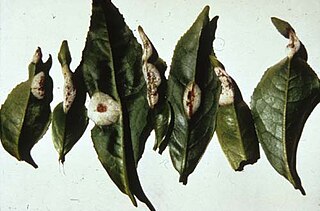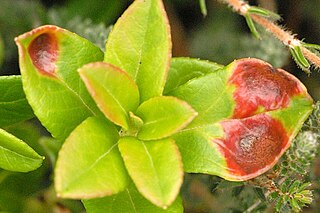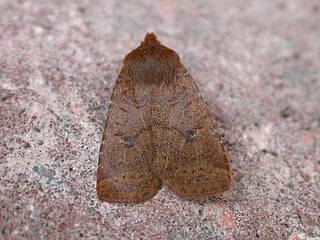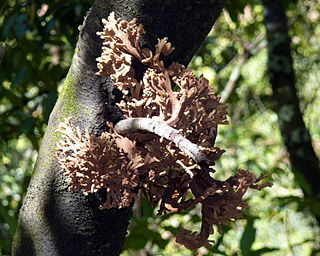
Eriophyidae is a family of more than 200 genera of mites, which live as plant parasites, commonly causing galls or other damage to the plant tissues and hence known as gall mites. About 3,600 species have been described, but this is probably less than 10% of the actual number existing in this poorly researched family. They are microscopic mites and are yellow to pinkish white to purplish in color. The mites are worm like, and have only two pairs of legs. Their primary method of population spread is by wind. They affect a wide range of plants, and several are major pest species causing substantial economic damage to crops. Some species, however, are used as biological agents to control weeds and invasive plant species.

Rhododendron calendulaceum, the flame azalea, is a species of Rhododendron endemic to the southern and central Appalachians of North America. All parts of this plant are poisonous to humans. Rhododendron calendulaceum is a popular cultivated plant due to its bright yellow, orange or red flowers.
Microsphaera vaccinii is a plant pathogen.
Exobasidium burtii is a species of fungus in the family Exobasidiaceae. It is a plant pathogen.
Exobasidium reticulatum is a plant pathogen.

Exobasidium vaccinii var. japonicum is a plant pathogen.

Exobasidium vexans is a plant pathogen affecting tea.

Exobasidium vaccinii, commonly known as “red leaf disease,” or “Azalea Gall,” is a biotrophic species of fungus that causes galls on ericaceous plant species, such as blueberry and azalea. Exobasidium vaccinii is considered the type species of the Exobasidium genus. As a member of the Ustilagomycota, it is a basidiomycete closely related to smut fungi. Karl Wilhelm Gottlieb Leopold Fuckel first described the species in 1861 under the basionym Fusidium vaccinii, but in 1867 Mikhail Stepanovich Voronin later placed it in the genus Exobasidium. The type specimen is from Germany, and it is held in the Swedish Museum of Natural History. Exobasidium vaccinii, in current definition from John Axel Nannfeldt in 1981, is limited on the host Vaccinium vitis-idaea. This idea is used in most recent papers on E. vaccinii.
Microsphaera penicillata var. vaccinii is a plant pathogen.

The Exobasidiomycetes are a class of fungi sometimes associated with the abnormal outgrowths of plant tissues known as galls. The class includes Exobasidium camelliae Shirai, the camellia leaf gall and Exobasidium vaccinii Erikss, the leaf and flower gall. There are eight orders in the Exobasidiomycetes, including the Ceraceosorales, Doassansiales, Entylomatales, Exobasidiales, Georgefischeriales, Malasseziales, Microstromatales and the Tilletiales. Four of the eight orders include smut fungi. The families Ceraceosoraceae and Malasseziaceae were formally validated in 2009 for the orders Ceraceosorales and Malasseziales, respectively.

Exobasidium is a genus of fungi in the family Exobasidiaceae. The genus has a widespread distribution, especially in northern temperate regions, and contains about 50 species. Many of the species in this genus are plant pathogens that grow on Ericaceae. The comprising fungi are parasitic in nature, especially on various heath plants where they cause galls.

Phomopsis is a genus of ascomycete fungi in the family Diaporthaceae. It was previously in the Valsaceae family.

Conistra vaccinii, the chestnut, is a moth of the family Noctuidae. The species was first described by Carl Linnaeus in 1761. It is distributed throughout Europe, North Africa and east through the Palearctic to Siberia.

John-Axel Nannfeldt, born 18 January 1904 in Trelleborg and deceased 4 November 1985 in Uppsala, was a Swedish botanist and mycologist.

Laurobasidium is a genus of fungi in the Exobasidiaceae family. The genus contains two species. One is Laurobasidium lauri, found in Europe and described by W. Jülich in 1982, and another is L. hachijoense, found in Hachijō-jima, Japan and described in 1985.
Dichelopa vaccinii is a species of moth of the family Tortricidae. It is found on Rapa Iti in the South Pacific Ocean.
Filatima vaccinii is a moth of the family Gelechiidae. It is found in North America, where it has been recorded from Alberta, British Columbia, Manitoba and New Jersey.
Tricholochmaea vaccinii, the blueberry leaf beetle, is a species of skeletonizing leaf beetle in the family Chrysomelidae. It is found in North America.

Exobasidium camelliae is a phytopathagenic fungus that infects ornamental shrubs of the Camellia genus. It absorbs nutrients from the host through its haustoria and causes the leaves of the host plant to be thicker and lighter green than usual. It forms a hymenium between cells four to six layers above the lower epidermis which is subsequently sloughed off to reveal its basidia.

Exobasidium parvifolii is a species of fungus.













